Red and BBs home.....the adventure continues
- Thread starter British Red
- Start date
-
Hey Guest, Early bird pricing on the Summer Moot (29th July - 10th August) available until April 6th, we'd love you to come. PLEASE CLICK HERE to early bird price and get more information.
You are using an out of date browser. It may not display this or other websites correctly.
You should upgrade or use an alternative browser.
You should upgrade or use an alternative browser.
Did a full inspection on the hives today.
Delighted to report that both our colonies made it through the Winter and appear to be doing well.
We are advised to offer the bees a little fondant as the weather is so wet and cold that many nectar bearing flowers are late.
The bees are nibbling at it - but not really interested

Bees on fondant by British Red, on Flickr
This is why - capped off honey available in the brood box - no shortage of carbohydrate here!
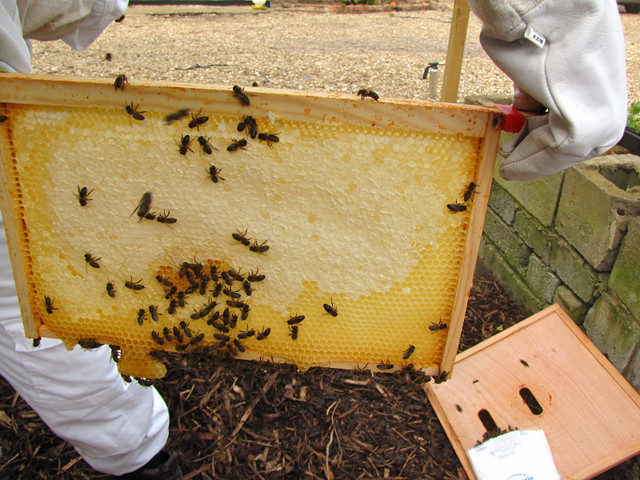
Honey being capped off by British Red, on Flickr
It was nice to see sealed and unsealed brood too - proof that the queens are laying

Brood by British Red, on Flickr
There is a problem though - next to no pollen. We should see a lot of cells that look like this....
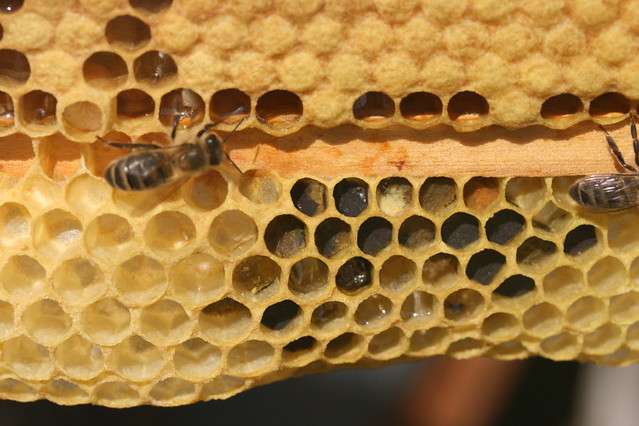
Brace comb, Pollen and Brood by British Red, on Flickr
The pollen is the different coloured unsealed "chalky looking" stuff.
Pollen is bee protein food (honey is carbohydrate). Without pollen the bees cannot feed brood (bee babies). Therefore the colony size (which will have fallen to about 10,000 in the Winter) , will not expand quickly enough for the main nectar flow - meaning the amount of honey stored is severely reduced.
Fortunately there is a solution - a pollen feed (you can use a real or artificial pollen in a sugar fondant - this is the real stuff)
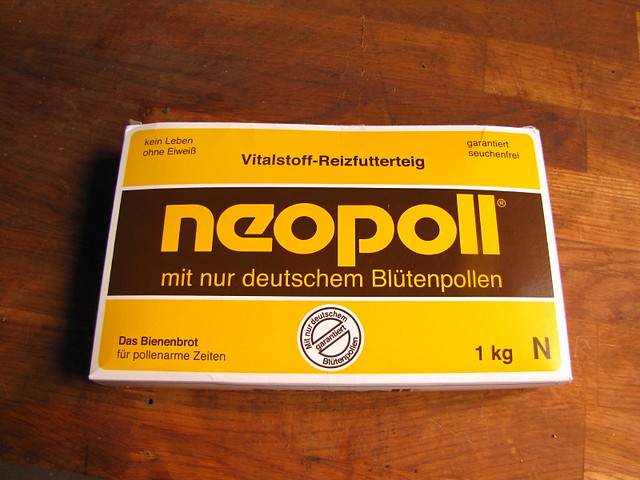
neopoll by British Red, on Flickr
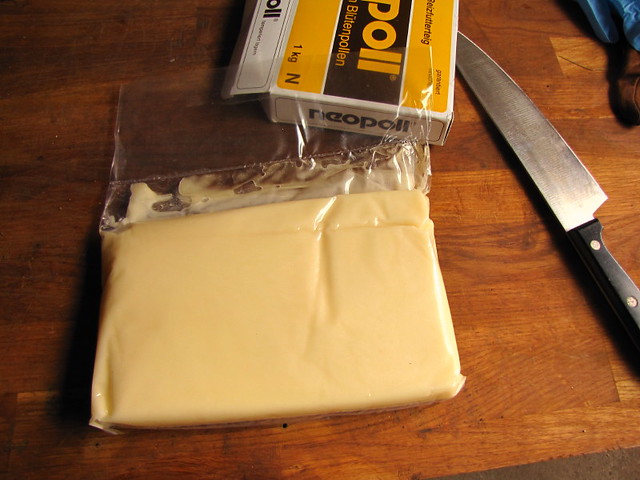
neopoll unboxed by British Red, on Flickr
The technique to deed it to the bees is to cut off a lump and stick it on a piece of greaseproof paper

lump of neopoll by British Red, on Flickr
put another piece of greasproof on top and roll out to 1/2" thick (I'm using a jam jar to do this)
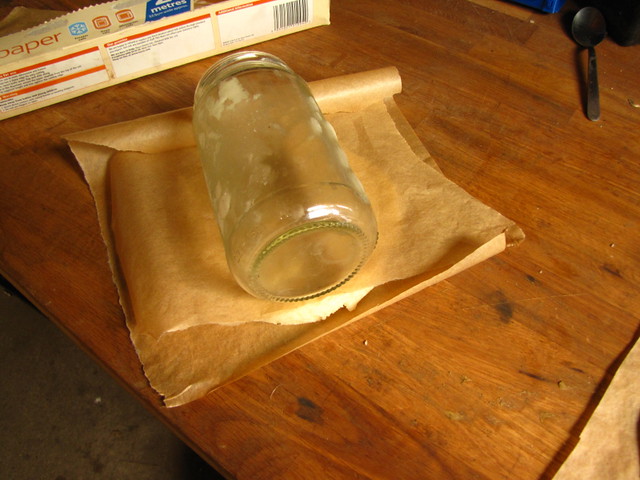
rolling out neopoll by British Red, on Flickr
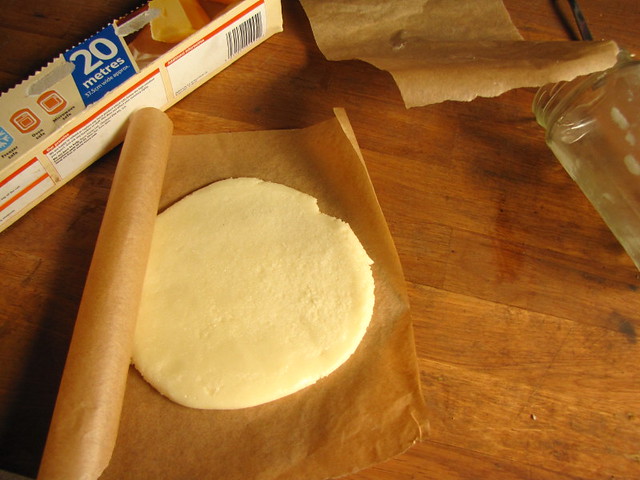
neopoll patty by British Red, on Flickr
The patty goes directly on top of the frames in the brood box.
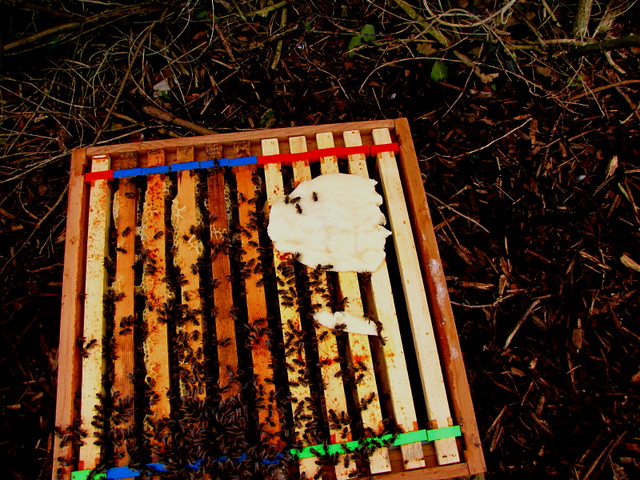
neopoll on frames by British Red, on Flickr
We will take a peek in a few days. If the pollen food has been consumed, we will add more. The bees are bringing in real pollen - but there is none stored so its touch and go if its enough.
Hopefully the extra pollen "hit" will help the bees breed a larger, more vigorous colony.
Red
Delighted to report that both our colonies made it through the Winter and appear to be doing well.
We are advised to offer the bees a little fondant as the weather is so wet and cold that many nectar bearing flowers are late.
The bees are nibbling at it - but not really interested

Bees on fondant by British Red, on Flickr
This is why - capped off honey available in the brood box - no shortage of carbohydrate here!

Honey being capped off by British Red, on Flickr
It was nice to see sealed and unsealed brood too - proof that the queens are laying

Brood by British Red, on Flickr
There is a problem though - next to no pollen. We should see a lot of cells that look like this....

Brace comb, Pollen and Brood by British Red, on Flickr
The pollen is the different coloured unsealed "chalky looking" stuff.
Pollen is bee protein food (honey is carbohydrate). Without pollen the bees cannot feed brood (bee babies). Therefore the colony size (which will have fallen to about 10,000 in the Winter) , will not expand quickly enough for the main nectar flow - meaning the amount of honey stored is severely reduced.
Fortunately there is a solution - a pollen feed (you can use a real or artificial pollen in a sugar fondant - this is the real stuff)

neopoll by British Red, on Flickr

neopoll unboxed by British Red, on Flickr
The technique to deed it to the bees is to cut off a lump and stick it on a piece of greaseproof paper

lump of neopoll by British Red, on Flickr
put another piece of greasproof on top and roll out to 1/2" thick (I'm using a jam jar to do this)

rolling out neopoll by British Red, on Flickr

neopoll patty by British Red, on Flickr
The patty goes directly on top of the frames in the brood box.

neopoll on frames by British Red, on Flickr
We will take a peek in a few days. If the pollen food has been consumed, we will add more. The bees are bringing in real pollen - but there is none stored so its touch and go if its enough.
Hopefully the extra pollen "hit" will help the bees breed a larger, more vigorous colony.
Red
Very much depends on the weather Niels. Guys I know last year got about 4 kilos of honey per hive. The weather was really bad though. In a good year? 20 to 40 kilos per hive.
We have two hives on the go - if I were to get 40 kilos total, I would be happy. Longer term we plan to expand to 4 hives - so in a good year 100 to 120 kilos - perhaps two hundred jars, plus wax and some left over for mead
We have two hives on the go - if I were to get 40 kilos total, I would be happy. Longer term we plan to expand to 4 hives - so in a good year 100 to 120 kilos - perhaps two hundred jars, plus wax and some left over for mead
The bees are getting more active.
Today we opened the entrance block to its widest setting as on these warm days there is quite the "traffic jam" at the reduced entrance.
We also checked the pollen feed - its all gone! The bees on the warmer days are coming back laden with pollen which is a great sign, but think we will give a little more suplementary pollen to ensure they rear plenty of brood for when the nectar flow really kicks in.
I also decided that we could do with a couple of "ekes" to help with feeding etc.. An eke is a simple frame that is shallower than a brood box or super. Its basically there to add a little extra depth to keep the roof off a feeder, fondant etc.. Having a few of these in a variety of depths is a useful aide. Now I coould buy these - but its a four sided rectangle made of wood - and they cost about £20 delivered. I figured I could make them for £3 each out of a length of 2.5" by 0.5" pine.
The first thing to do was to measure the size I needed - 46cm / 18" square.

Measure queen excluder by British Red, on Flickr
Using a mitre box, I cut two lengths of timber to this length
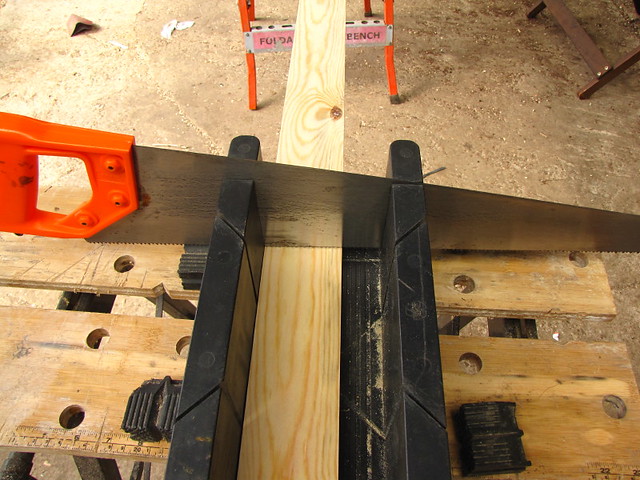
Mitre box by British Red, on Flickr
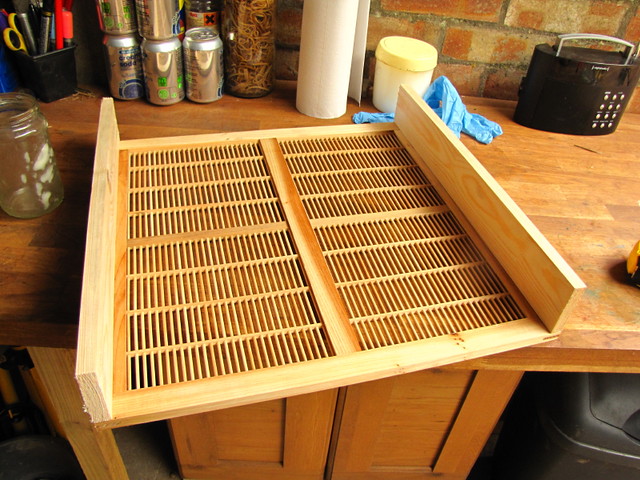
Two eke long sides by British Red, on Flickr
Clearly the two remaining (short) sides have to fit inside the existing (long) sides. Measuring the width of two pieces of timber says the short sides need to be 3cm less - so 43cm.
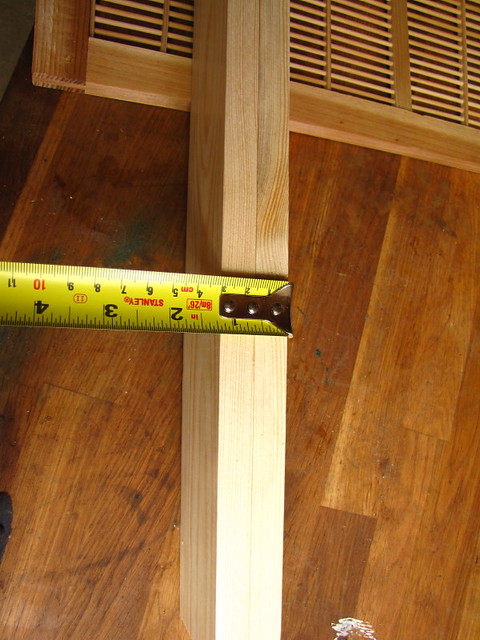
Check wood thickness by British Red, on Flickr
Cutting two short sides give us the basic shape of the eke
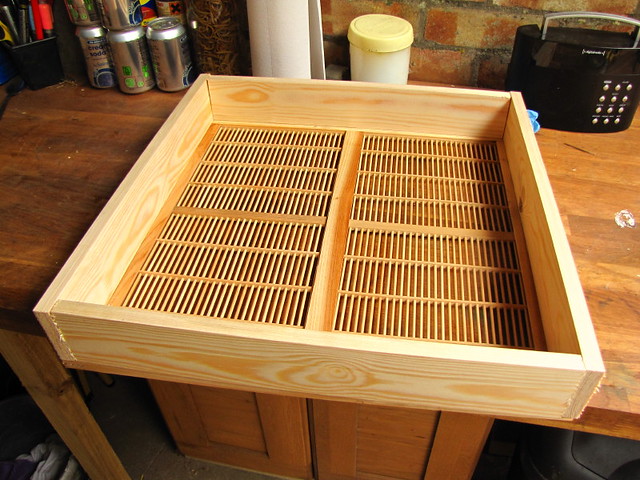
two long two short eke sides by British Red, on Flickr
The butted joints were sanded clean
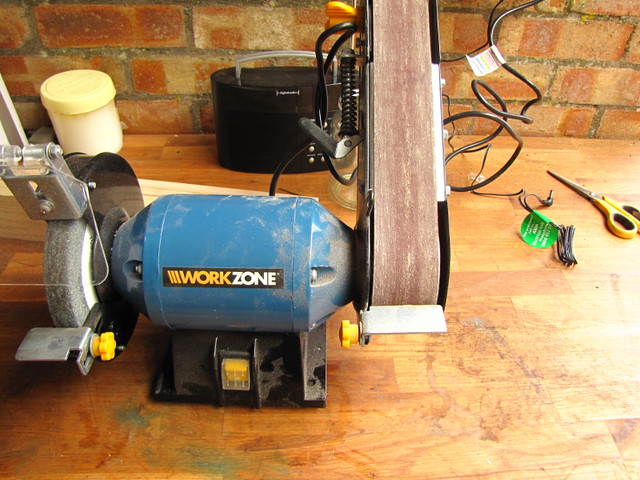
Bench sander by British Red, on Flickr
Glued
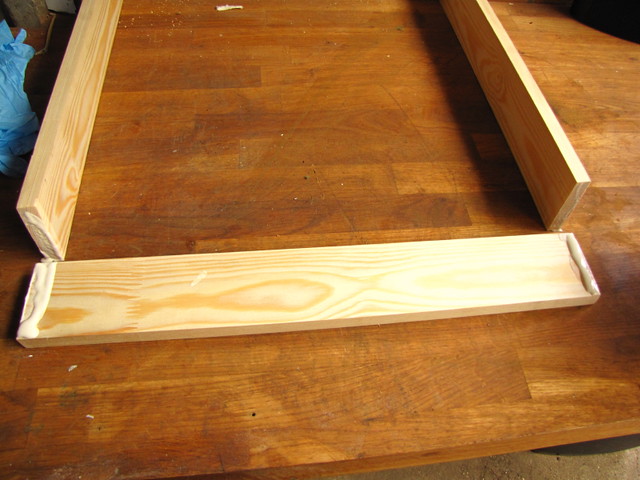
Glue on eke by British Red, on Flickr
and pinned in place.....

Finished pinned ekes by British Red, on Flickr
The eke can sit on top of frames to keep the roof of, for example, pollen feed, or on top of the crown board to hold the roof just above a feeder like this....

Eke on crown board by British Red, on Flickr
Well, thats it - a small simple thing, but around thirty quid saved on making two of them!
Red
Today we opened the entrance block to its widest setting as on these warm days there is quite the "traffic jam" at the reduced entrance.
We also checked the pollen feed - its all gone! The bees on the warmer days are coming back laden with pollen which is a great sign, but think we will give a little more suplementary pollen to ensure they rear plenty of brood for when the nectar flow really kicks in.
I also decided that we could do with a couple of "ekes" to help with feeding etc.. An eke is a simple frame that is shallower than a brood box or super. Its basically there to add a little extra depth to keep the roof off a feeder, fondant etc.. Having a few of these in a variety of depths is a useful aide. Now I coould buy these - but its a four sided rectangle made of wood - and they cost about £20 delivered. I figured I could make them for £3 each out of a length of 2.5" by 0.5" pine.
The first thing to do was to measure the size I needed - 46cm / 18" square.

Measure queen excluder by British Red, on Flickr
Using a mitre box, I cut two lengths of timber to this length

Mitre box by British Red, on Flickr

Two eke long sides by British Red, on Flickr
Clearly the two remaining (short) sides have to fit inside the existing (long) sides. Measuring the width of two pieces of timber says the short sides need to be 3cm less - so 43cm.

Check wood thickness by British Red, on Flickr
Cutting two short sides give us the basic shape of the eke

two long two short eke sides by British Red, on Flickr
The butted joints were sanded clean

Bench sander by British Red, on Flickr
Glued

Glue on eke by British Red, on Flickr
and pinned in place.....

Finished pinned ekes by British Red, on Flickr
The eke can sit on top of frames to keep the roof of, for example, pollen feed, or on top of the crown board to hold the roof just above a feeder like this....

Eke on crown board by British Red, on Flickr
Well, thats it - a small simple thing, but around thirty quid saved on making two of them!
Red
Well now the bees are really awake now! Breeding up and bringing home pollen and nectar
The Blackthorne is in full bloom
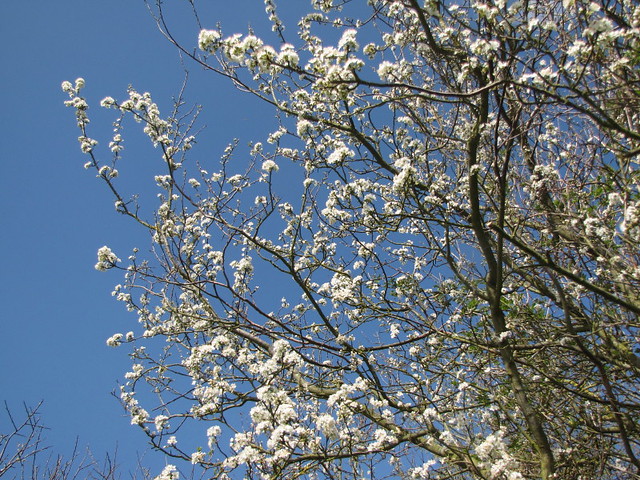
Blackthorn Blossom by British Red, on Flickr
..and our bees are taking full advantage

Honey Bee on Blackthorn by British Red, on Flickr
They like tulips too!

Buckfast Bee on Tulip by British Red, on Flickr
Its also interesting to see them take water - they use this both as a drink, to cool the hive through evaporation on hot days and for larvae. We built a bee waterer by putting large rocks in a chicken waterer
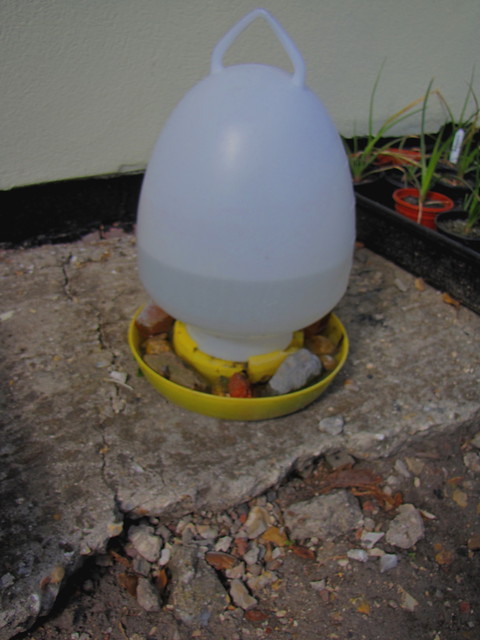
Bee Waterer by British Red, on Flickr
As you can see - they seem happy with it
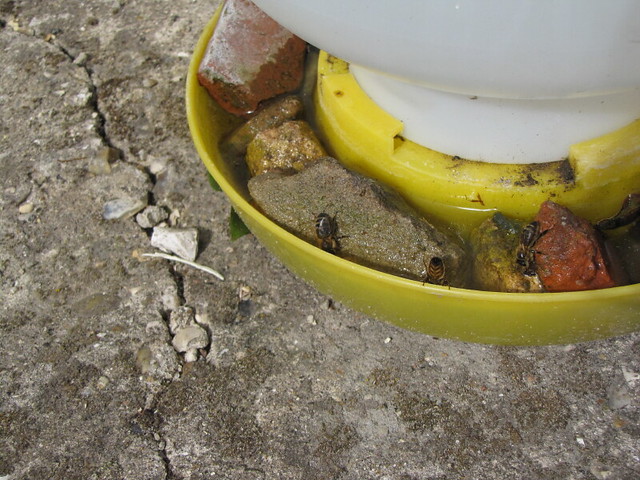
Bees Drinking by British Red, on Flickr
We decided today to do a full hive inspection. This revealed a lot of the development stages of a hive which I thought may be of interest.
One frame of "foundation" we had put in to the brood box was hardly changed....but the bees had begun to "draw out" the foundation into comb. You can see lighter coloured beeswax being added at the top right corner

Foundation Being Drawn by British Red, on Flickr
Eventually the comb will harden and darken into full comb like this
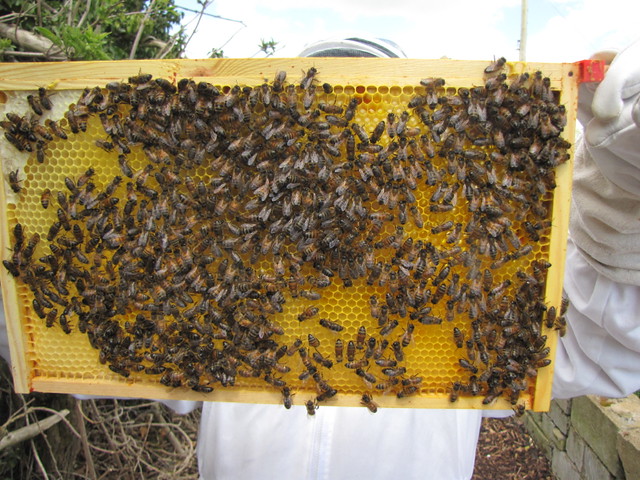
Drawn Comb by British Red, on Flickr
The comb can contain a number of things.....
On this frame, nectar has been turned to honey. When the water level is low enough the bees "cap off" the honey to preserve it...this can be seen below with the white capped honey circles in red
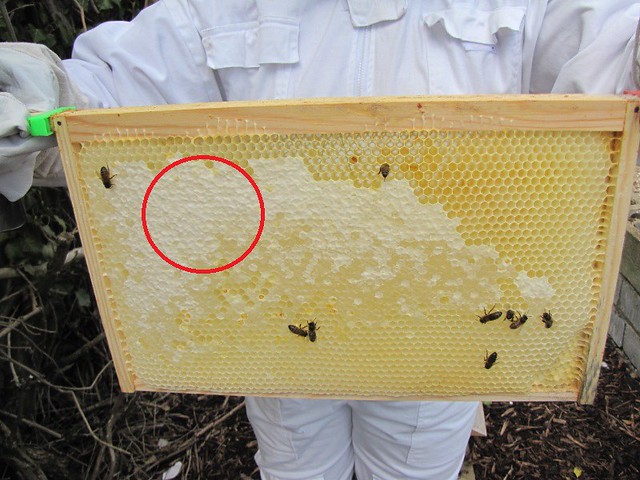
Capped Honey by British Red, on Flickr
In other areas of drawn comb a dusty powder can be seen. This is pollen - used mainly to feed young bees (brood). Honey can be thought of as carbohydrate. pollen as protein.

Pollen Stores by British Red, on Flickr
As well as "stores" (pollen and honey), all the stages of "brood" (young bees) were present.
Some cells had already hatched and worker bees were cleaning them up. On the following photo you can see bees with their heads in cells - this a bee "makeover show" before new eggs are laid (it can also be bees feeding larvae)
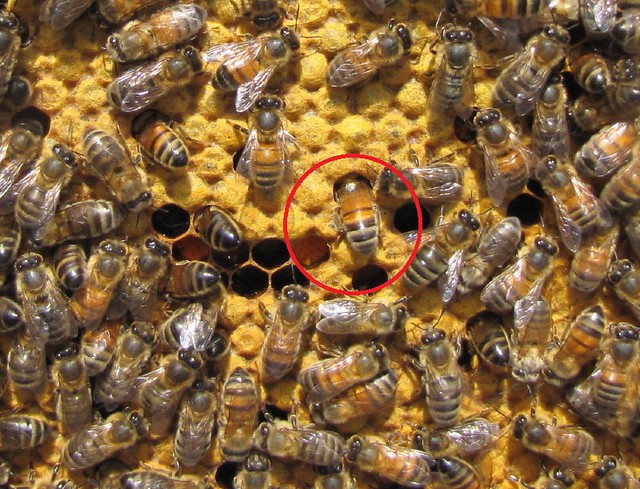
Worker cleaning cell by British Red, on Flickr
In some cells, fresh eggs had been laid - the white, thread like objects seen here
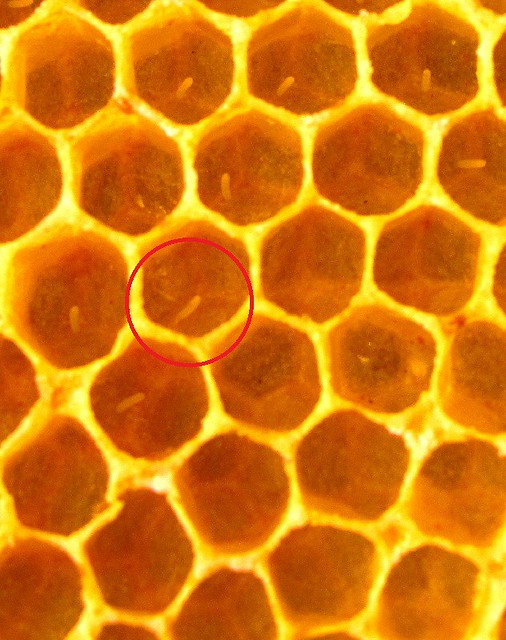
Bee Eggs by British Red, on Flickr
Those eggs hatch and become larvae - the white curled objects circles below
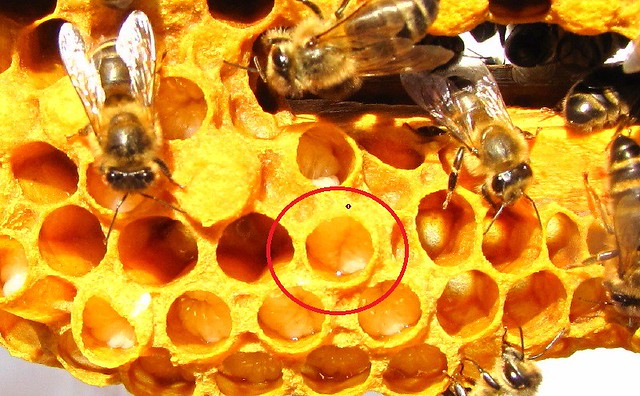
Larvae by British Red, on Flickr
Eventually the larvae pupate. The pupae are capped over whilst they change into young bees. In this photo you can see larvae (red circle) and "sealed brood" (black circle).

Larva (Red) surrounded by sealed brood (Black) by British Red, on Flickr
The brood shown above is worker brood (infertile female) - you can tell because its pretty much flat.
Occasionally you will see one or a cluster of "domed" sealed brood - these are "drone cells" housing male bees - shown below

Drone Cell by British Red, on Flickr
Queens are born from queen cells (they are identical eggs to workers but fed differently and develop into queens). We don't have any of those - which is a good thing as they can be a sign of swarming.
So a lot going on....the brood box is nearly full and the bees are expanding by up to 1500 bees a day - there are no signs of swarming but the bees need room to expand, so in the next post we will expand the size of the hive and give room for the bees to store honey.
Red
The Blackthorne is in full bloom

Blackthorn Blossom by British Red, on Flickr
..and our bees are taking full advantage

Honey Bee on Blackthorn by British Red, on Flickr
They like tulips too!

Buckfast Bee on Tulip by British Red, on Flickr
Its also interesting to see them take water - they use this both as a drink, to cool the hive through evaporation on hot days and for larvae. We built a bee waterer by putting large rocks in a chicken waterer

Bee Waterer by British Red, on Flickr
As you can see - they seem happy with it

Bees Drinking by British Red, on Flickr
We decided today to do a full hive inspection. This revealed a lot of the development stages of a hive which I thought may be of interest.
One frame of "foundation" we had put in to the brood box was hardly changed....but the bees had begun to "draw out" the foundation into comb. You can see lighter coloured beeswax being added at the top right corner

Foundation Being Drawn by British Red, on Flickr
Eventually the comb will harden and darken into full comb like this

Drawn Comb by British Red, on Flickr
The comb can contain a number of things.....
On this frame, nectar has been turned to honey. When the water level is low enough the bees "cap off" the honey to preserve it...this can be seen below with the white capped honey circles in red

Capped Honey by British Red, on Flickr
In other areas of drawn comb a dusty powder can be seen. This is pollen - used mainly to feed young bees (brood). Honey can be thought of as carbohydrate. pollen as protein.

Pollen Stores by British Red, on Flickr
As well as "stores" (pollen and honey), all the stages of "brood" (young bees) were present.
Some cells had already hatched and worker bees were cleaning them up. On the following photo you can see bees with their heads in cells - this a bee "makeover show" before new eggs are laid (it can also be bees feeding larvae)

Worker cleaning cell by British Red, on Flickr
In some cells, fresh eggs had been laid - the white, thread like objects seen here

Bee Eggs by British Red, on Flickr
Those eggs hatch and become larvae - the white curled objects circles below

Larvae by British Red, on Flickr
Eventually the larvae pupate. The pupae are capped over whilst they change into young bees. In this photo you can see larvae (red circle) and "sealed brood" (black circle).

Larva (Red) surrounded by sealed brood (Black) by British Red, on Flickr
The brood shown above is worker brood (infertile female) - you can tell because its pretty much flat.
Occasionally you will see one or a cluster of "domed" sealed brood - these are "drone cells" housing male bees - shown below

Drone Cell by British Red, on Flickr
Queens are born from queen cells (they are identical eggs to workers but fed differently and develop into queens). We don't have any of those - which is a good thing as they can be a sign of swarming.
So a lot going on....the brood box is nearly full and the bees are expanding by up to 1500 bees a day - there are no signs of swarming but the bees need room to expand, so in the next post we will expand the size of the hive and give room for the bees to store honey.
Red
Hugh, pardon my ignorance but how dose the feeding turn the bee into the queen has there ever been a study done on it?
Oh yes mate.
There are three type of bees
Drones (male)
Workers (infertile female)
Queens (fertile female)
Queens mate once over the course of a week with mating flights (they mate mate several times in this period), They then store the semen in their body.
When laying an egg, the queen can fertilise it with stored semen. If she does this a female egg is laid. If she lays an egg but does not fetilise it a male egg is laid.
Once the female eggs are laid, they are fed a substance called royal jelly for three days and then weak nectar honey and become workers.
If the hive is crowded, or the queen dead or failing, the workers will feed royal jelly much longer and one or more of the worker eggs witll become a "queen cell". Eventually a "virgin queen is born" and will fly to mate with drones. In an overcrowded colony, the colony will "split" (swarm), with some workers leaving the hive with one queen and establishing a new colony, others remain.
Hope thats clear? Its weird, but how it works!
There are three type of bees
Drones (male)
Workers (infertile female)
Queens (fertile female)
Queens mate once over the course of a week with mating flights (they mate mate several times in this period), They then store the semen in their body.
When laying an egg, the queen can fertilise it with stored semen. If she does this a female egg is laid. If she lays an egg but does not fetilise it a male egg is laid.
Once the female eggs are laid, they are fed a substance called royal jelly for three days and then weak nectar honey and become workers.
If the hive is crowded, or the queen dead or failing, the workers will feed royal jelly much longer and one or more of the worker eggs witll become a "queen cell". Eventually a "virgin queen is born" and will fly to mate with drones. In an overcrowded colony, the colony will "split" (swarm), with some workers leaving the hive with one queen and establishing a new colony, others remain.
Hope thats clear? Its weird, but how it works!
I get it, it's like the description of how all the dinosaurs are female in Jurassic park (they need a hormone boost to make them male or in this case female), would I be right in assuming the royal jelly has some form of hormone component to achieve this?
Busy bees mate 
We just got shares in 5 allotments. The chap who owns them, keeps chickens, ducks, geese, pigs, a goat and a sheep. So we bought some hens (blue star) to go in with his, got shares on the pigs for half the cost of the food and slaughter costs. ( he has 2 sows about to be bred, and 3 weaners fattening up.) Been thinking about bees, not sure though. Worth it do you think?
We just got shares in 5 allotments. The chap who owns them, keeps chickens, ducks, geese, pigs, a goat and a sheep. So we bought some hens (blue star) to go in with his, got shares on the pigs for half the cost of the food and slaughter costs. ( he has 2 sows about to be bred, and 3 weaners fattening up.) Been thinking about bees, not sure though. Worth it do you think?
I get it, it's like the description of how all the dinosaurs are female in Jurassic park (they need a hormone boost to make them male or in this case female), would I be right in assuming the royal jelly has some form of hormone component to achieve this?
I honestly don't know - I understand what happens - but not the biology of it
Been thinking about bees, not sure though. Worth it do you think?
Its a high up front investment in terms of time and money to get going - you can easily reduce the money by building your own hives etc., but that adds to the time. It can be a lucrative sideline though....you can keep many hives and get 60lbs of honey per hive in a good year - at several quid a pound sold at the gate!
Farmers will pay you to keep bees on their fields - it increases pollination of crops....
I think its worth it
Right so we have a brood box thats about full and a rapidly expanding bee colony.
In order to prevent the coony trying to swarm, and to give room for them to make us lots of honey, we need to increase the size of the hive. In the Winter its useful to have a small hive - the bees burn up honey to work their muscles and heat the hive, but the bigger the hive, the more work is required, and the more likely the colony is to run out of food. In the Spring, heating becomes less of a problem and space a larger one - so we increase the hive size.
First thing to do is to clean up the top of frames in the brood box. Bees build "brace comb" - comb above and below the frames we gave them. This is natural wild behaviour. but does not help with the addition of more space. Any "brace comb" is scraped off the top of the brood box
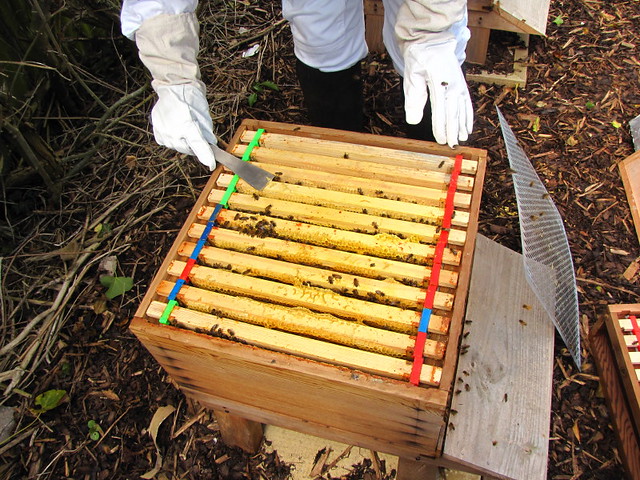
Clean off brace comb by British Red, on Flickr
Next a "queen excluder" is placed on top of the brood box. This is a metal, plastic or wooden sheet with holes large enough for workers to pass through, but too small for the queen to get through. In this way, any frames above the queen excluder cannot contain eggs or larvae - just honey!
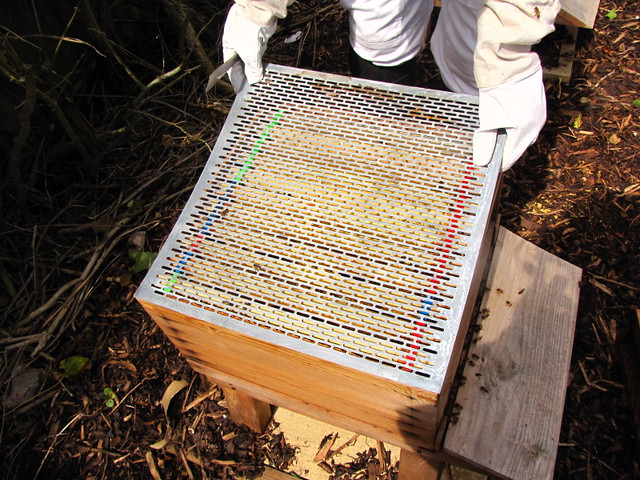
Queen Excluder by British Red, on Flickr
A "super" full of 11 frames is placed on top of the "brood box". The super frames are a little shallower than brood frames. The queen is confined in the brood box by the queen excluder and all the new bees will be raised down there. The supers are just for the workers to store honey in.

Honey Super by British Red, on Flickr
The crown board is placed above the super
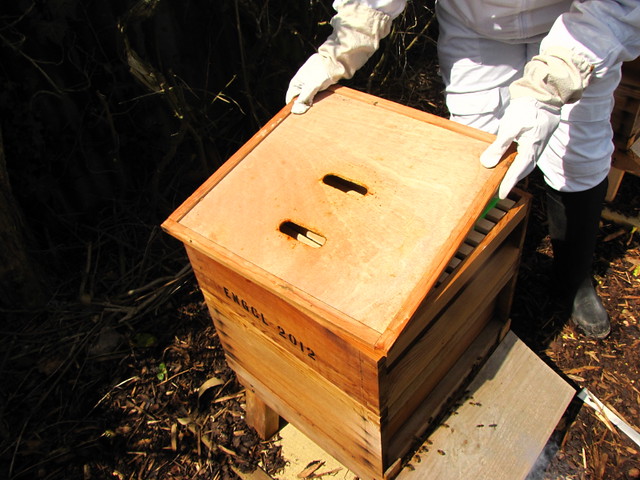
Crown Board by British Red, on Flickr
Since the nights are still cold, we'll leave the insulation on top of the crown board for a few more weeks. Better insulation means less honey burned to heat the hive!
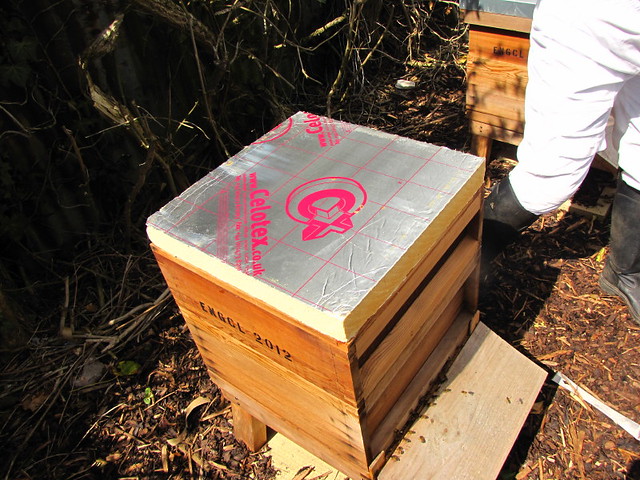
Replace Insulation by British Red, on Flickr
The roof goes on top of the insulation.
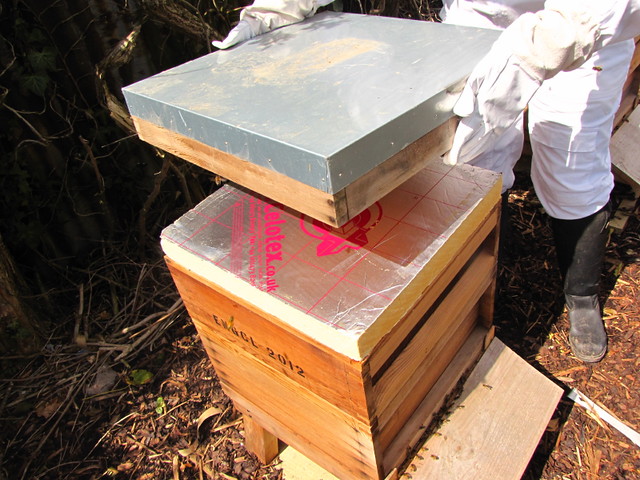
Add Roof by British Red, on Flickr
There we have it - lots more room for the colony to work the flowers and store honey. The rate of storage should increase as more and more bees are born in the brood box - peaking at about 75,000 bees per hive
Red
In order to prevent the coony trying to swarm, and to give room for them to make us lots of honey, we need to increase the size of the hive. In the Winter its useful to have a small hive - the bees burn up honey to work their muscles and heat the hive, but the bigger the hive, the more work is required, and the more likely the colony is to run out of food. In the Spring, heating becomes less of a problem and space a larger one - so we increase the hive size.
First thing to do is to clean up the top of frames in the brood box. Bees build "brace comb" - comb above and below the frames we gave them. This is natural wild behaviour. but does not help with the addition of more space. Any "brace comb" is scraped off the top of the brood box

Clean off brace comb by British Red, on Flickr
Next a "queen excluder" is placed on top of the brood box. This is a metal, plastic or wooden sheet with holes large enough for workers to pass through, but too small for the queen to get through. In this way, any frames above the queen excluder cannot contain eggs or larvae - just honey!

Queen Excluder by British Red, on Flickr
A "super" full of 11 frames is placed on top of the "brood box". The super frames are a little shallower than brood frames. The queen is confined in the brood box by the queen excluder and all the new bees will be raised down there. The supers are just for the workers to store honey in.

Honey Super by British Red, on Flickr
The crown board is placed above the super

Crown Board by British Red, on Flickr
Since the nights are still cold, we'll leave the insulation on top of the crown board for a few more weeks. Better insulation means less honey burned to heat the hive!

Replace Insulation by British Red, on Flickr
The roof goes on top of the insulation.

Add Roof by British Red, on Flickr
There we have it - lots more room for the colony to work the flowers and store honey. The rate of storage should increase as more and more bees are born in the brood box - peaking at about 75,000 bees per hive
Red
I honestly don't know - I understand what happens - but not the biology of it
Never the less it has peeked my interest, and there is much reading to be done!!!!
btw if you have any wax going spare for sale can you put my name on the list mate found a really cool way to use it of late in a piscatorial / metallurgical way.
Sure - wont be for a while. How much do you need?
Honest answer, how much you got?
Not much at the moment - just some brace comb I've trimmed. I'm trying not to remove wax because every pound of wax uses up 5 pounds of honey! In a couple of years though I will need to replace lots of comb as it wears out....won't be more than a few ounces here and there till then tbh
Been stung yet Red?
Once when eating honeycomb over the hive, once when driving a fence post right by the hive, once when a bee got caught up inside my suit because I didn't wear boots. My own silly fault each time and not too bad a pain. Get the sting out quickly and its no drama.
